The Last Harvest: Paintings of Rabindranath Tagore

The Last Harvest was an exhibition of Rabindranath Tagore's paintings to mark the 150th anniversary of Tagore's birth. It was commissioned by the Ministry of Culture, India and organised with the National Gallery of Modern Art (NGMA). It consisted of 208 paintings drawn from the collections of Visva Bharati and the NGMA. The exhibition was curated by art historian R. Siva Kumar. Asia Art Archive later classified the exhibition as a "world event".[1]
Within the 150th birth anniversary year it was conceived as three separate but similar exhibitions,and travelled simultaneously in three circuits. The first selection was shown at Museum of Asian Art, Berlin,[2] Asia Society, New York,[3] National Museum of Korea,[4] Seoul, Victoria and Albert Museum,[5] London, The Art Institute of Chicago,[6] Chicago, Petit Palais,[7] Paris, Galleria Nazionale d'Arte Moderna, Rome, National Visual Arts Gallery (Malaysia),[8] Kuala Lumpur, McMichael Canadian Art Collection,[9] Ontario, National Gallery of Modern Art,[10] New Delhi, National Gallery of Modern Art, Mumbai.[11]
An illustrated catalogue, titled The Last Harvest: Paintings of Rabindranath Tagore, with essays by international Tagore experts was published to accompany the exhibition. The book covered Tagore's art and other aspects of his work and life.
The inclination to know and understand other cultures was innate to his personality, and contributed to his emergence as an artist. A world traveler and a creative artist with interest in cross-cultural contacts, he looked at the art of the countries he travelled to. Sometimes he did this with greater purposefulness and self-awareness, as he did during his 1916 visit to Japan. But often he merely absorbed them, and without discussion or record allowed them to sink to the bottom of his awareness, from where they subliminally guided his thoughts and rose to the surface when required. Primitive and modern art that he saw during his many travels abroad played such a role in his emergence as an artist.
—R. Siva Kumar, The Last Harvest: Paintings of Rabindranath Tagore (book), 2011.
The Last Harvest
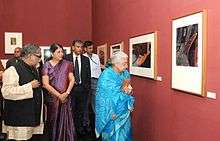
Surrounded by several painters Rabindranath had always wanted to paint. Writing and music, playwriting and acting came to him naturally and almost without training, as it did to several others in his family, and in even greater measure. But painting eluded him. Yet he tried repeatedly to master the art and there are several references to this in his early letters and reminiscence. In 1900 for instance, when he was nearing forty and already a celebrated writer, he wrote to Jagadishchandra Bose, "You will be surprised to hear that I am sitting with a sketchbook drawing. Needless to say, the pictures are not intended for any salon in Paris, they cause me not the least suspicion that the national gallery of any country will suddenly decide to raise taxes to acquire them. But, just as a mother lavishes most affection on her ugliest son, so I feel secretly drawn to the very skill that comes to me least easily." He also realized that he was using the eraser more than the pencil, and dissatisfied with the results he finally withdrew, deciding it was not for him to become a painter.
Although he gave up the hope of becoming an artist around 1900, Rabindranath continued to doodle in his manuscripts. He turned struck-out words into ornamental motifs and sometimes linked the scratched out words on the pages of his manuscripts into an art-nouveau-like arabesque. This continued without much change until the end of 1923. Then almost all of a sudden on the pages of the notebook he used during his tour of 1924 his doodles proliferated and assumed more representational and expressive intent. Victoria Ocampo who spotted these during his stay in Argentina as her guest was impressed and found artistic merit in them. "He played with erasures," she wrote, "following them from verse to verse with his pen, making lines that suddenly jumped into life out of this play: prehistoric monsters, birds, faces appeared."

These doodles in the Purabi manuscript that excited Ocampo in 1924 mark the beginnings of Rabindranath"s artistic career. Rabindrnath himself recognised such doodles as the beginnings of his art and wrote: "The only training I had from my young days was the training in rhythm in thought, the rhythm in sound. I had come to know that rhythm gives reality to that which is desultory, which is insignificant in itself. And therefore, when the scratches in my manuscript cried, like sinners, for salvation, and assailed my eyes with the ugliness of their irrelevance, I often took more time in rescuing them into a merciful finality of rhythm than in carrying on what was my obvious task." He also called this his "unconscious training in drawing." And described the imagery that emerged as follows: "... when the vagaries of the ostracized mistakes had their conversion into rhythmic inter-relationship, giving birth to unique forms and characters. Some assumed the temperate exaggeration of a probable animal that had unaccountably missed its chance of existence… Some lines showed anger, some placid benevolence, through some lines ran an essential laughter. ... These lines often expressed passions that were abstract, evolved characters that hung upon subtle suggestions."
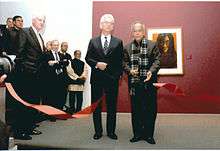
After four years of involved doodling, Rabindranath began to do independent paintings in 1928. And six years after she first noticed the expressive strength of his doodles in 1930 Ocampo helped him organize the first exhibition of his paintings in Paris. This was followed by a string of exhibitions across Europe, in Russia, England and America. He was the first Indian artist to be exhibited widely in the West. He felt that different as his works were from the art of his Indian contemporaries they stood a better chance to be appreciated in the West. And many of his first viewers in the West, and these included seasoned artists and connoisseurs, were appreciative. However, they were fleeting encounters and they saw his work as an extension of Western art and not in relation to the totality of his oeuvre or in relation to India. His familiarity with the "primitive" and modern traditions of art played a role in his emergence as a painter. But it is only in the context of post-forties Indian art that Rabindranath's paintings find their true place in the history of modernism and it is in this context they need to be looked at.

Though Rabindranath began to paint only in 1928 when he was sixty-seven he painted well over two thousand paintings. It was as Abanindranath Tagore said a "volcanic eruption" that continued unabated for the last thirteen years of his life. Coming at the end of a hugely creative life spreading across six decades and involving work in several mediums and genres the question of how his paintings relate to the rest of his oeuvre rises. Is there a unifying theme or universal "truth" running through all his creations? It would be difficult to give a categorical and simple answer but the following words of Rabindranath from My Pictures, a statement he made in 1930 in connection with his paintings might contain a lead.
"But one thing which is common to all arts is the principle of rhythm which transforms inert materials into living creations. My instinct for it and my training in its use led me to know that lines and colours in art are no carriers of information; they seek their rhythmic incarnation in pictures. Their ultimate purpose is not to illustrate or to copy some outer fact or inner vision, but to evolve a harmonious wholeness which finds its passage through our eyesight into imagination. It neither questions our mind for meaning nor burdens it with unmeaningness, for it is, above all, meaning."
Organizational theme of the exhibition
The Last Harvest is an international exhibition commissioned and fully supported by the Government of India as part of Rabindranath's 150th birth anniversary celebrations. It brings together a representative selection of his works culled from the collections of Rabindra Bhavana and Kala Bhavana at Santiniketan, and the National Gallery of Modern Art.
Rabindranath's life, his works and the history of his institutions mark a progress from nationalism to universal humanism. His paintings belong to the period of universal humanism and linked as they may be to personal experiences they have a universal appeal. In consonance with it Rabindranath did not title his drawings and paintings. He also did not date most of them. Thus they come to us as an open-ended oeuvre, encouraging us to respond to them with our sensibilities and find linkages between them. In other words, he encourages the viewers to embark on a curatorial process. This exhibition is one such effort.
In this exhibition the works are grouped into what may be considered four important facets of his oeuvre. His earliest paintings grew out of the doodles he did in his manuscripts while attempting to turn crossed out words and discarded lines into visually exciting motifs. These have an element of playful inventiveness and involve morphological cross-projections that defy perceptual experience. If the subliminal played an important part in his first paintings, painting itself led him to pay attention to the pageant of forms in nature. The landscapes included in these selections are a token of this shift. As he progressed he also began to see the human body not merely as form but as gestures carrying within them the seeds of visual narration and theatre – ambivalent as they may remain without the benefit of names. A third group of paintings bring this into focus. And finally there are his representations of the human face; hovering between hieratic masks and individualised portraits, they turn countenance into characters.
The four groups may be highlighted thus:
Group 1 This group contains some of his earliest paintings, they are either geometrical or arabesque and have an element of playful inventiveness involving morphological cross-projections that defy reality.
Group 2 Nature was an enduring theme in Rabindranath's writings and songs, he felt a deep companionship with nature since his childhood. A more meditative and observant come through in his landscapes and flower pieces.
Group 3 As a playwright and actor Rabindranath was sensitive to gesture and its dramatic and narrative potential; the paintings in this group bring this into focus.
Group 4 This group consists of his representations of the human face into which he reads traces of social and personal life. They are products of observation and psychological probing.
Finally a word about the title. For Rabindranath who welcomed contact with other cultures to foster creativity, and for whom the touchstone of authenticity was not the lineage of one"s language but one"s ability to make it one"s own, the value of art lay not in its source or style but in being an imperative of life.
And painting was the last enchantment of his life, his last personal imperative. "I am hopelessly entangled in the spell that the lines have cast all around me…. If I were a free agent ... unburdened by any care," he wrote to close friend in 1928 just when he was embarking on his career as a painter, "I would live by the Padma and gather a harvest of pictures and nothing but pictures to load the Golden Boat of Time with." He was burdened with too many commitments to allow himself that privilege but the harvest has been good (well over two thousand paintings in thirteen years) and this exhibition carries a small part of it eighty years after he himself had ferried it across the world for the first time.
The International tour of Rabindranath Tagore's Paintings
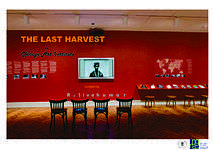 Last Harvest in Chicago
Last Harvest in Chicago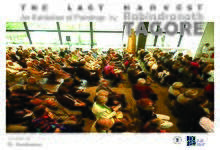 The Last Harvest at Berlin
The Last Harvest at Berlin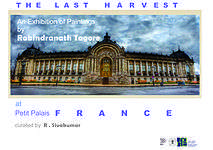 The Last Harvest at Petit palais
The Last Harvest at Petit palais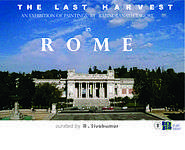 The Last Harvest in Rome
The Last Harvest in Rome Last Harvest in Berlin
Last Harvest in Berlin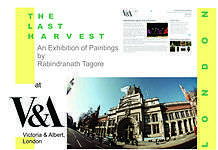 Last Harvest at V&A
Last Harvest at V&A
Reception
The Last Harvest received highly appreciable reviews across the globe. The British newspaper Daily Telegraph reported,"Tagore is such a fascinating figure that for the fans of his work the art will illuminate his poems and fictions; and for those coming cold, this (The Last Harvest) serves as a delightful introduction." The Independent rated the exhibition as one of the five best shows to have opened in London in 2011.[12] Mumbai Boss declared it the best museum exhibition saying, "At this gathering of about 100 works, one of the largest since his death, fluidly curated by historian R. Siva Kumar, the viewer was given a peek into a less assured Tagore, as a 60-something artist, who used his innate sense of linguistic artistry to permeate his at-times fantastical works. There were animals invented, idyllic landscapes, portraits and drawings that showed him to have an astonishing grasp of what it meant to endow a visual expression with the same raw beauty as its written equivalent."[13] Daily News and Analysis reported, "Tagore's imagination created paintings that underline his sheer genius. Yet, they were untitled, left to viewers to interpret." According to The Times of India, The Last Harvest was "A rare display of artworks by Tagore". "Like a skipping stone, Tagore’s style glanced off a variety of inspirations – wood-cuts, surrealist imagery, North American folk art – and yet was sharply distinctive. The Last Harvest, curated by Professor Raman Siva Kumar of Visva-Bharati University, presents one of the most elaborate exhibitions of Tagore’s paintings that we’ve seen." reported Firstpost.
See also
- Rabindra Chitravali
- Kala Bhavana
- Rabindranath Tagore
- R. Siva Kumar
- National Gallery of Modern Art
- Kolkata Museum of Modern Art
References
- ↑ "The Last Harvest - Asia Art Archive".
- ↑ "Staatliche Museen zu Berlin - Kalender". Smb.museum. Retrieved 2012-12-18.
- ↑ Current Exhibitions Upcoming Exhibitions Past Exhibitions. "Rabindranath Tagore: The Last Harvest | New York". Asia Society. Retrieved 2012-12-18.
- ↑ "Exhibitions | Special Exhibitions". Museum.go.kr. Retrieved 2012-12-18.
- ↑ "Rabindranath Tagore: Poet and Painter - Victoria and Albert Museum". Vam.ac.uk. Retrieved 2012-12-18.
- ↑ http://www.artic.edu/sites/default/files/press_pdf/Tagore.pdf
- ↑ "Le Petit Palais - Rabindranath Tagore (1861-1941) - Paris.fr". Petitpalais.paris.fr. 2012-03-11. Retrieved 2012-12-18.
- ↑ "Welcome to High Commission of India, Kuala Lumpur (Malaysia)". Indianhighcommission.com.my. Retrieved 2012-12-18.
- ↑ "McMichael Canadian Art Collection - The Last Harvest: Paintings by Rabindranath Tagore". Mcmichael.com. 2012-07-15. Retrieved 2012-12-18.
- ↑ http://www.ngmaindia.gov.in/pdf/The-Last-Harvest-e-INVITE.pdf
- ↑ http://articles.timesofindia.indiatimes.com/2013-04-18/people/38646057_1_rabindranath-tagore-paintings-exhibition
- ↑ http://ngmaindia.gov.in/pdf/NGMA-E-newsletter-option17.pdf
- ↑ http://mumbaiboss.com/2013/12/23/best-of-mumbai-2013-culture/
